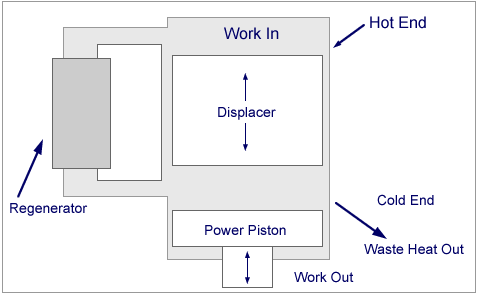How it works
Of several thermodynamic cycles with ideally limiting Carnot
efficiency, the Stirling cycle is the only one that is practical
to implement. The displacer and power piston reciprocate in a cylinder
filled with a fixed charge of working gas, typically helium. As the
displacer reciprocates, it shuttles the working gas through the
regenerator between the hot and cold regions. The pressure
wave created by varying average gas temperature is applied to
the power piston causing it to reciprocate. The displacer and
power piston are phased so that more work is put into the power
piston during the expansion stroke, when most of the gas is in
the hot space, than the work the piston returns to the gas a
half cycle later to compress the mostly cold gas. The net surplus
of expansion work over compression work is extracted as useful work
by the power piston. All external heat is supplied at the cycle
maximum temperature and rejected at the cycle minimum temperature.
The regenerator absorbs heat from the gas as the gas passes through
it from the hot zone to the cold zone, then returns the stored heat
to the gas on its return from the cold zone to the hot zone with
minimal thermal loss.
The essential parts of a Stirling engine are
schematically illustrated in the figure below.
The same basic machine
operated in reverse becomes a refrigerator or cryocooler.
|

